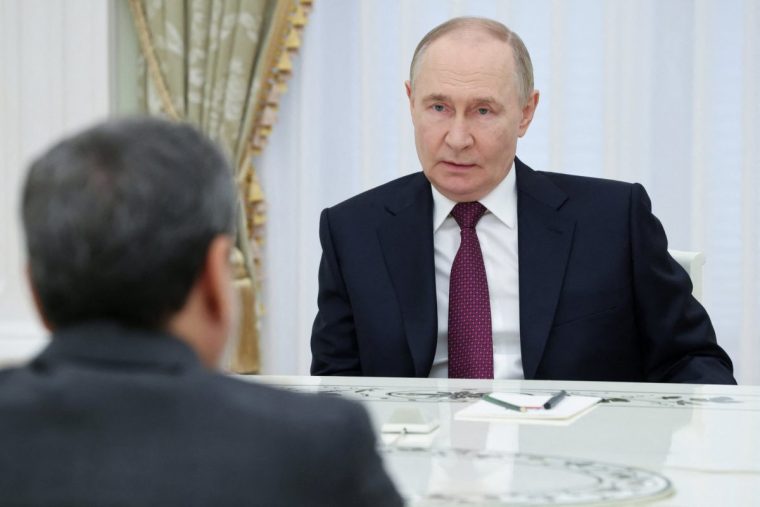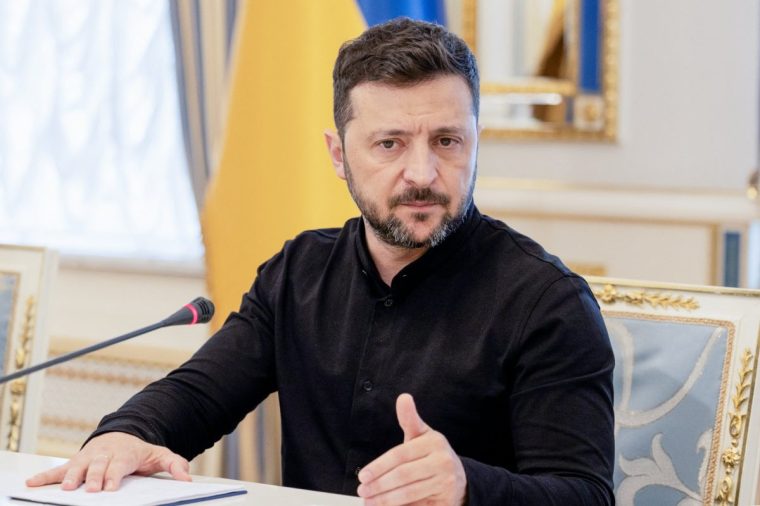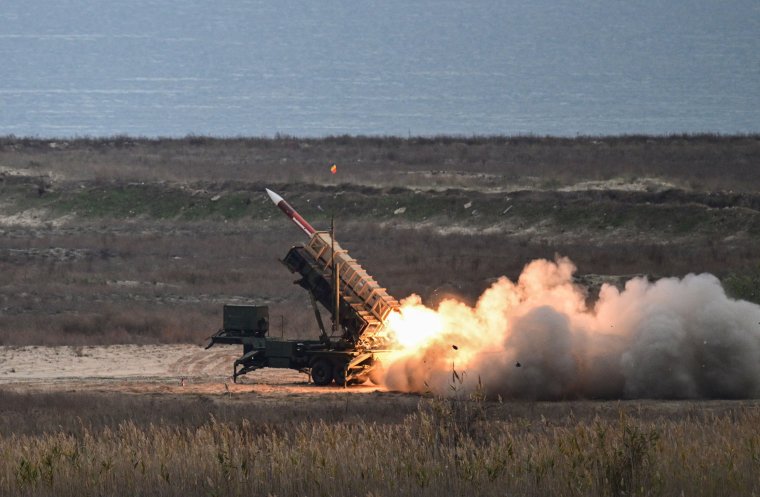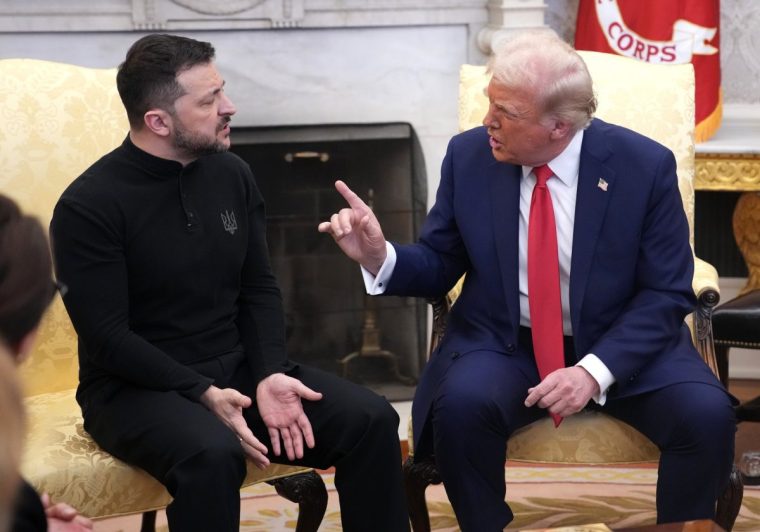Vladimir Putin is stepping up his war again, recently claiming that ‘all of Ukraine is ours’
The US halt in air defence supplies and other weapons to Ukraine could deal a significant setback to its forces at one of the most dangerous moments of the war.
The halted munitions include interceptors for crucial Patriot air defence systems, precision artillery rounds, and missiles used by the Ukrainian air force on American-made F-16 jets, according to Pentagon officials.
These weapons have played a vital role in Ukraine’s defence against escalating Russian attacks during a key stage of the war, now in its third year.
A review of the US stockpiles had been reportedly under way for months but it was not immediately clear how military support for other countries would be affected.
“This decision was made to put America’s interests first following a DOD [Department of Defence] review of our nation’s military support and assistance to other countries across the globe,” White House spokeswoman Anna Kelly said.
“The strength of the United States armed forces remains unquestioned – just ask Iran.”
‘Not good news’ for Ukraine
“This is not good news for Ukraine,” said Dr Marina Miron, researcher at the War Studies Department at King’s College London. This halt could give the Russians further advantages, since “they currently hold the upper hand both militarily on the battlefield and in terms of long-range strikes”.
“It’s a nightmare if you get promised something, and you already planned for where you put these things, or which units receive what, and then it’s delayed, and then it doesn’t happen,” Dr Miron said.
“So it does create a huge strain. I would argue that maybe that’s one of the biggest strains on the military strategic side of Ukrainian planners, this uncertainty”.

The decision comes as Ukraine enters a deadly new phase in the war, with Russia launching what Ukraine described as its largest air assault since the full-scale invasion began in February 2022 at the weekend, involving 477 drones and decoys as well as 60 missiles. Last month, Russia launched a record 5,337 Shahed-type drones at Ukraine.
In recent weeks, Russia has carried out almost nightly air assaults on Ukraine, deploying hundreds of drones and missiles.
Then last week Vladimir Putin declared that “all of Ukraine is ours”, in what appears to have been a shift in his war aims, which, following his initial failure to conquer Kyiv and the rest of Ukraine in 2022, reframed his priorities, annexing the Luhansk, Donetsk, Kherson and Zaporizhzhia regions.
But last week he told an economic forum in St Petersburg: “Wherever the Russian soldier treads is ours.”

Russian state media has also claimed that its forces have seized their first village in the Dnipropetrovsk region, an area Ukraine has never previously had to defend against Russian soldiers during the war. Ukrainian officials have denied the claim, but Volodymyr Zelensky said Russia has deployed sabotage units into border villages.
Russian forces are also gradually advancing in Pokrovsk, a key logistical hub in Donetsk, eastern Ukraine, whose capture would mark a significant battlefield win and move them closer to seizing full control of the Donetsk region.
The US suspension comes as Ukraine faces a shortage of air defence munitions, which are dwindling as Russia steps up its air attacks.
Ukraine having even fewer air defences and guided munitions “will further complicate the Ukrainian task, and that is all combined with the fact that Ukraine also suffers from manpower losses”, Dr Miron said. “It will now depend on how far Russia wants to go.”
The move to pause certain weapons shipments to Ukraine follows Zelensky’s urgent calls to Western allies to boost air defence support, although as Dr Miron said, this is inevitably dependent on the political climates of each country.

(Photo: Daniel Mihailescu/AFP)
Kyiv’s largest donor remains unpredictable
Since the start of Russia’s full-scale invasion, the US has been by far the largest single provider of military aid to Ukraine, supplying air defence systems, drones, rocket launchers, radars and other weapons and munitions.
But Donald Trump’s return to power increased the uncertainty around the future of US assistance to Kyiv. A tense Oval Office confrontation with Zelensky in March resulted in a temporary halt of all military shipments to Ukraine, but aid resumed about a week later after the two leaders smoothed over their differences.
On Thursday the Financial Times reported that Trump and Zelensky were expected to discuss the halt in a call on Friday, when the Ukrainian president would also raise potential future arms sales, citing people familiar with the planning.

At last week’s Nato summit in The Hague, Trump told a Ukrainian journalist that he would look for ways to deliver more Patriot missiles to Ukraine.
The Patriot missile systems are among the most advanced air defences, particularly effective against hypersonic and ballistic missile threats. Ukraine operates around six US-made Patriot batteries, which are vital in defending millions of civilians from Russian air attacks. However, Kyiv faces the risk of running low on missiles to supply these systems.
In April, Europe surpassed the US for the first time in total military aid to Ukraine, contributing €72bn (about £62.64bn) compared with the US’s €65bn (£55.8bn), according to the Kiel Institute for the World Economy, which monitors wartime aid.
Still, Dr Miron believes the US halting military air shipments “is not a good sign militarily, it’s not a good sign politically”.
“I’ve seen this several times with Trump, where he kind of gets angry publicly with, say, Zelensky, but does exactly the opposite of what one would expect, or he gets angry with Putin, but does something that actually benefits Putin, and I think this is something that we have to keep in mind,” she said.
US concerns may have valid ground
While the precise numbers on US stockpiles are not made public, the argument about scarcity “is not necessarily invalid”, said Dr Sidharth Kaushal, senior research fellow at the Royal United Services Institute in London.
The US inventory stockpiles “are not critically low”, as the country has successfully replenished its supplies, particularly for the Patriot systems, through buy-back programmes and redirecting shipments originally intended for export customers, rather than drawing from its own reserves, he said.
“The production rate of Patriot reached a record high in 2024 – growing by 30 per cent relative to 2023,” he pointed out.
“That being said, the argument about scarcity is not necessarily invalid. It merely reflects the fact that the requirement for Patriot, particularly in the Indo-Pacific, is growing significantly,” he said. “As such, the scarcity is relative and not absolute, and driven by increases on the demand rather than the supply side.”
Dr Kaushal went on to say that since initial diversions of Patriots “came at the expense of export partners, including some in the Middle East, there may be a belief, and indeed a contractual obligation, to deliver interceptors to partners who are in some cases within range of Iranian SRBMs [short-range ballistic missiles].”
The US decision could also be a way to force European countries to provide more assistance to Ukraine, “because this is not just about Ukraine” but “it is about a broader issue between the United States and the Europeans, especially as far as Ukraine and then Israel are concerned”, said Dr Miron.
Trump has repeatedly called on European allies to play a bigger role in supporting Ukraine, as well as boost their own defences.
